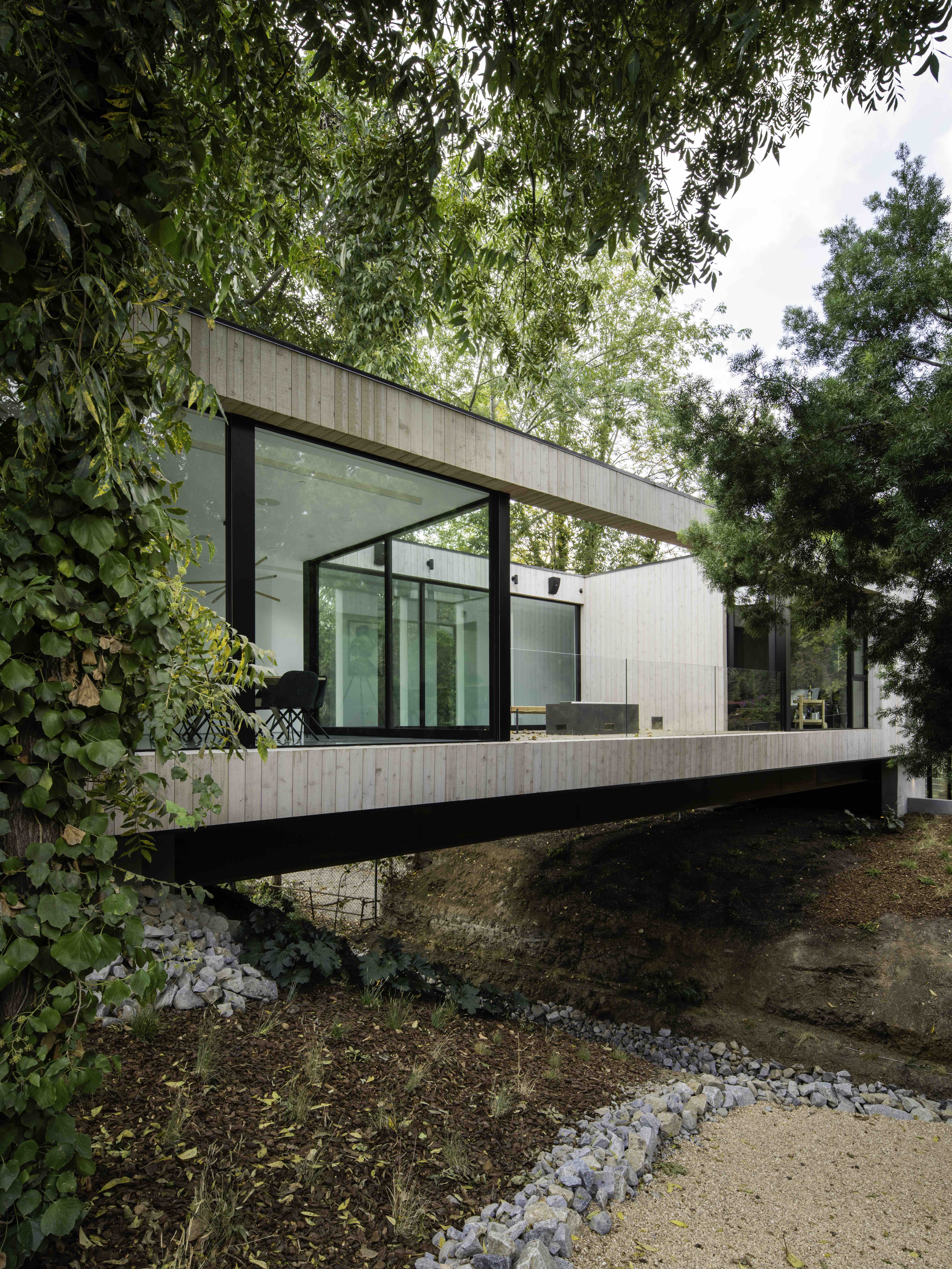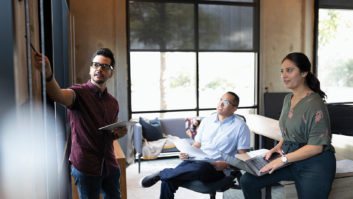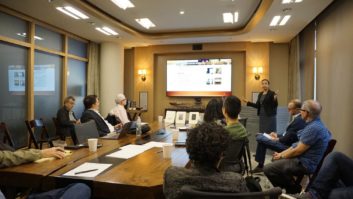A central part of this year’s CEDIA Expo is the Design Connection platform, which promises to bring together residential integrators with designers and architects through a pavilion on the show floor and several networking opportunities – including an integrator-led tour of the show floor for designers and a Bourbon and Brownies mixer. The pavilion has already been endorsed by the National Kitchen and Bath Association (NKBA), and was created as a result of feedback CEDIA received from its members.
As a preview to the Design Connection, we asked an integrator, Joe Whitaker from Thoughtful Home Design (St. Louis, MO and Dallas, TX), and a designer, Jassen Johnson from Tower Real Estate Group (St. Louis, MO), to get together and discuss the good (what they like about working with each other), the bad (what they would like to see changed), and the future of the technology/design relationship.
RESIDENTIAL SYSTEMS: Jassen, at what stage do you think the integrator should be brought into the job?
JASSEN JOHNSON: Typically what we’d like is to have some initial design work out of the way with the client before we bring the integrator in. So we will have a high-level floor plan, and then the technical side can play a role. Otherwise you’ve spent a lot of time backtracking and redesigning in order to accommodate both properly.

RS: Do you put the integrator directly in touch with the contractor, or do you act as an intermediary?
JASSEN JOHNSON: I am normally in the middle, mainly for control purposes, but there is also the design aspect of what we’re trying to get accomplished. If you’re good at what you do, you can take the needs of the client and recommendations from the technical people and make them better through how you’re integrating that into the design. A perfect example of that is just how important lighting is for a project. It’s not something that the client is necessarily taking into consideration, but if you set your lighting level in a particular design properly, that will make a big difference in how the device feels. But a typical client doesn’t necessarily know that.
RS: Joe, how do you like to work with a designer and when would you like to be brought in?
JOE WHITAKER: The number one person who can mess up a designer and the amazing atmosphere he/she created is a tech guy. By coming together early – the audio, the video, networking, the lighting – all of that complements the room so it becomes an actual part of the designed environment, and that is why it is so important.
JASSEN JOHNSON: It’s not only important from the beginning, but it’s also important to have touchstone design meetings during the course of the project. From a design perspective, I might spend a ton of time spec’ing perfect speaker grilles that will go on the ceiling, but if the speakers aren’t necessarily in line with the rest of the system, then you just wasted all that time and money obsessing about the grilles. The hardest thing about design, particularly when things are more modern and clean, is making sure that everything is symmetrical and in line with each other. That takes a lot more work than you think, and if you’re not working in tandem with all subcontractors – particularly on the technology side – then you’ve just totally missed the mark.
JOE WHITAKER: Jassen and I have experience working together with that – changing lighting fixtures on the fly. I am super picky about things being symmetrical, and those were key visits and meetings. The project could not have been as successful as it was in the end without touching base and making sure that electrical and design were always on the same page.

RS: Jassen, do you ever choose gear based on aesthetics over performance?
JASSEN JOHNSON: I don’t necessarily know that I ever give that too much consideration, because we have guys like Joe who will get us to the point no matter what it is that we’re requesting. So we’ve learned to lean on them to say this is what we want. If you want a certain thing to happen a certain way, and you’ve got a good guy, you know you will drill down until you figure it out.
RS: What about you, Joe? Do you ever choose gear based on the look over its performance?
JOE WHITAKER: That’s one of the reasons I like working with designers such as Jassen. We had this one project where we had an in-wall subwoofer instead of a freestanding one that would be out in the room, and we knew the client wanted a certain performance level. I got together with Jassen to figure out how we can have the client’s performance expectations fit so that it would also match the design. For us, obviously, performance is always an aspect, but when we’re working with the designer we take that into consideration and then work backwards.
JASSEN JOHNSON: That is a perfect example. If you know that you are using a slightly less dynamic subwoofer because you need to be able to get a certain type of sectional couch in this room, then it’s a give and take. You tell the client to either get a different couch or it’s not going to sound right.
JOE WHITAKER: It’s me trusting Jassen to make these spaces in these environments absolutely gorgeous and him trusting me to provide the performance specs for that side. Those kind of relationships lead to some pretty amazing things.
All about CEDIA Expo’s Design Connection:
CEDIA Expo Announces Debut of Design Connection ProgramNKBA Endorses CEDIA Expo as the Event for Design and Technology Collaboration and Integration
Industry Experts to Lead Inaugural Design Connection Tour at CEDIA Expo 2018
RS: What habits of integrators would you like to change?
JASSEN JOHNSON: I think there’s a tendency on the tech side to introduce products to clients that are going to ultimately be so complicated that the clients won’t want to use them. You might be able to get them to pay for it and get it implemented, but they’re too complicated for them to actually understand, so they get frustrated and they just won’t use it. Some integrators go for the new and exciting as opposed to finding something that is more user-friendly.
RS: Joe, same question but about designers – what kind of habits do designers have that you wish they wouldn’t?
JOE WHITAKER: I’ve never, ever experienced this with Jassen, but there are some other designers I’ve dealt with where looks count over function, as far as the usage of a room goes. There’s an example from a couple of years ago that I often use. It was a small man-cave-style room, and it was gorgeous, and the guy wanted to add a TV, but this particular designer was all about this genuine bear throw rug that was an actual Grizzly. It was one of those things where design overpowers function. It got to the point where I had to ask which one of these two items – the TV or the bear rug – did he think the client is going to look at more. That was the end of the argument.
When design takes over the function of a room it can be a bit of a hindrance. It ends up becoming not only an uncomfortable situation for the designer and the technology professional, but it could become uncomfortable for the home builder or the customer. And that’s a turnoff, so a lot of times we’ll back off from those decisions with a sort of “maybe that could be retrofitted later.”
At the end of the day, the number one person to make happy is the client. So sometimes you have to bend to make it a comfortable experience.
RS: What kind of wishlist of services do you want from an integrator or a designer?
JOE WHITAKER: Professional designers need to realize that we need them. We really want to work with them – because that’s how these amazing spaces happen. I think that designers don’t think that we feel that way, but it is a prevalent thought among integrators, and it is the feeling you get from the industry at -large when you’re talking to people. That is why you see a lot more CEDIA push in that area, because there has been an outcry in the industry.
JASSEN JOHNSON: I think that works on the designer side, too. Whether you like it or not, from a design perspective you can’t avoid technology – and the technology actually becomes almost as important, if not more so, from the perspective of the visual outcome of the space, because you’ve got to take it into consideration. You know you can’t ignore it.
It only enhances everything you’re doing from a design perspective. You really have to think about it in all aspects of the design. If you think about it in tandem with a good team, it only makes the product better. It’s become the opposite of what used to be the case. From the very beginning, you should be able to sit down with your technological consultant and your client and say, “Okay, let’s globally think of this project and all the places where technology could potentially be involved here” – from fireplace to mechanical equipment to lighting and sound – and meet whatever the client’s expectations are. It is a pretty cool part of the design process, and it makes the project much better.
RS: What do you see the future holding for kitchen and bath AV and IoT? How far do you think it will go throughout the whole house?
JASSEN JOHNSON: We’re working on a commercial development right now that’s specifically based off of thinking about what office space is going to be 10 or 15 years from now. I was sitting at home on a Saturday morning watching my 6-, 5-, and 2-year-old kids play at home, and they spent half the morning interacting with Alexa – tell me a joke; sing me that song; tell me what the weather is going to be. My kids are going to be those people working in those offices 10 or 15 years from now, and they’re growing up having voice interaction with their environment. So we’re designed this building now, and it will actually have a personality. We’ll name the building “Martin” or something, and it’s going to have a website that interacts with tenants and some touchscreen technology, but will also have some kind of voice interaction within the building.
So I think that’s one of the things that you’re going to see particularly in kitchens and bathrooms – you’re going to have more voice interactions with the technology that’s already there. I think it’s going to be much more robust.
JOE WHITAKER: We’re going to see a lot more of those devices come to the whole home control ecosystem in the very near future. That’s the next frontier for home technology because we’ve already taken living rooms and bedrooms to how far we can push them. Taking those next steps, where you’re interacting with the home through voice, is an important thing. That’s going to be a big thing in the future, and it won’t be pushed out in a really successful way without the design community’s backing.
JASSEN JOHNSON: I think it’s particularly interesting in kitchens. I think we’ll get there with some of the technology that you already see. Just put yourself in a perfect example: I’m cutting raw chicken and, all of a sudden, I’m seeing a pot on my stove burner overflow. My hands are covered in salmonella, but if I can tell the stove to turn down through voice interaction, my problem is solved.
JOE WHITAKER: It is all about quality of life. I know for a fact that Jassen works as hard as I do. Our time is the most valuable thing. If I save 10 seconds a day, 365 days a year, over 10 years through smart home and voice control technologies, the quality of life improves. Those are things that are worth more than money.
RS: What do you both hope comes out of CEDIA’s Design Connection and bringing everybody together for the first time?
JOE WHITAKER: I really think the Design Connection pavilion is going to be great. It’s the first time ever anything at CEDIA is being endorsed by the NKBA [National Kitchen & Bath Association], and that’s huge. Plus the two tours are where I think a huge impact is going to come out of this because you’re going to have designers and architects actually walked through the trade show floor through the eyes of the technology professionals—that’s a proposition that has never been done before.
I’m really looking forward to this being kind of a teetering point where those relationships channel through, because it hasn’t been shown correctly previously. It is finally a chance to say, “You know design and technology and architecture should all go hand in hand. It should be a team effort. We have to do this together.”
JASSEN JOHNSON: With the Design Connection pavilion, from a design perspective, you know we’re visual. So when you can physically have the opportunity to not only interact with somebody on it with regard to the technology, but you can experience and create and touch it and feel it and understand how these things are coming to light – it can make a big difference from a design perspective.
It really is about bringing everybody together for a full understanding of how to integrate these things together, because if you don’t, then you’re not really nailing the project.
Click here for the latest CEDIA 2018 news.
RS: How far could you see this whole design connection going?
JASSEN JOHNSON: I think the perfect example is to think about it from the office perspective I mentioned earlier. Sometimes things excel in the commercial side and they get implemented on the residential side, and vice versa. I think the pendulum is going to be swinging a little bit more towards understanding what the capabilities are on the residential side and then they’re going to be start being implemented on the commercial side.
JOE WHITAKER: I entirely agree with that. I would say over the last year it’s started to become more obvious. You see it in hospitality. Technology is changing, and it’s evolving into something more along the lines of where I live my life. I have one of those little Garmin Alexa things my truck, so I could talk to Alexa for directions and play music, but also when I pull up to my house I say, “Let’s open the garage door,” and it opens. I’m starting to expect these things outside of my house. I expect them when I’m at a hotel or restaurant – everywhere I go.
JASSEN JOHNSON: I think this whole technological availability of these different things – that are much more user friendly than technology used to be – is why you’re going to start seeing these devices across the board everywhere because it makes your life so much easier. And from a physical perspective, there’s so much more attainable that is just going to keep ramping up.










